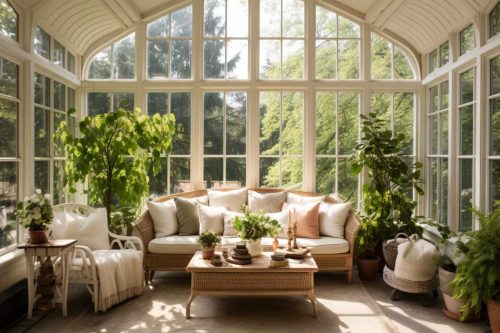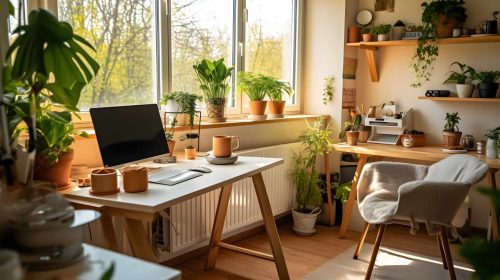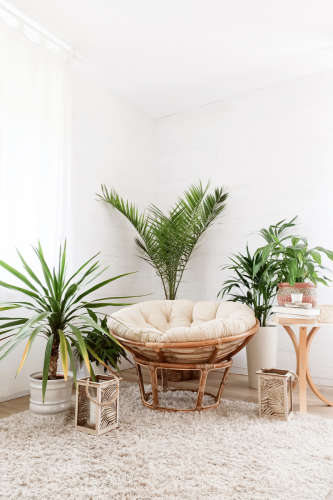WHAT DO YOU WANT TO LEARN MORE ABOUT?
Part 2 of Biophilic Design: Mastering the Art of House Plants in Interior Design
“Every room needs a pop of color and a pop of Nature” – Holley Pokora

Embracing nature indoors can transform a living space, not only aesthetically but also for one’s well-being. Bringing the outside in with house plants offers a refreshing element to interior design, creating a tranquil and vibrant atmosphere. One of the simplest and least expensive ideas to refresh and enhance your home’s interior is with Mother Nature! I love plants and love how they add color, structure, and height to any room. I often plan plants for a client when I am planning a room.
I move my plants around my home to observe which windows they like; I play with them like decor pieces, adding them to accessories in shelves, on table tops, and windowsills. It’s so easy to go to Lowe’s – mine in Plymouth Meeting, PA happens to have a wonderful, healthy collection of indoor plants and fun planters and stands – and treat myself to a new plant! My latest is a small lace fern:

We may forget that they also have numerous health benefits. With the rise of biophilic design, the use of houseplants in interior decorating has become even more popular.
As we talked about last month in my blog: In Biophilic Design, What’s That?, biophilic design incorporates natural elements into indoor spaces to create a connection with nature. Houseplants are a perfect example of this concept, and it goes beyond using houseplants as simple decoration; it’s a deeply fulfilling hobby that imparts routine and responsibility. Whether it’s finding creative ways to display your plants or mastering the essentials of plant care, the journey enriches daily life. My experience has taught me practical tips to turn my home into a green retreat, inspiring anyone who visits.
Key Takeaways
- House plants enhance living spaces aesthetically and improve well-being.
- Selecting and caring for the right plants is a rewarding part of home life.
- Creative plant placement can infuse your interior design with life and serenity.

The Benefits of House Plants
Indoor greenery isn’t just for show; I find house plants boost my home’s environment and my day-to-day mood. Here’s exactly how they do that.
Air Quality Improvement
House plants can be natural air purifiers. For instance, Snake plants (Sansevieria) and spider plants (Chlorophytum comosum) are known to filter indoor air pollutants. This table below lists a few common house plants and the specific toxins they help to reduce:
Spider Plant: Formaldehyde, Xylene, Toluene
Snake Plant: Benzene, Formaldehyde, Trichloroethylene, Xylene, Toluene
Peace Lily: Ammonia, Benzene, Formaldehyde, Trichloroethylene
Wellness and Mood Enhancement
My mood often gets a lift when I’m surrounded by plants. It’s not just me—studies suggest that house plants can increase feelings of wellness. Aloe vera, for example, isn’t only good for skin; having it around can also make me feel calmer. Here’s a quick list of plants and how they may boost my well-being:
- Aloe Vera: Promotes relaxation and has air-purifying qualities.
- Lavender: Known for its stress-relieving scent.
- Jasmine: Its fragrance can lead to better sleep quality.

Choosing the Right Plants
In selecting the right green companions for your home, it’s crucial to consider the environment they’ll thrive in and align them with your decor style.
Light and Space Considerations
Before picking out plants, take stock of the natural light available in your space. Some plants, like Snake plants and ZZ plants, are resilient in low-light conditions while others, such as Fiddle leaf figs and Orchids, crave bright, indirect sunlight. Reflect on where you have room too; a large Monstera might be imposing in a tiny bathroom, but a Air plants or Succulents could be perfect.
- Low Light: Snake plants, ZZ plants
- Medium Light: Pothos, Spider plants
- Bright Light: Fiddle leaf figs, Orchids
Also, consider the humidity of your room. Bathrooms with higher humidity are great for Tropical plants, whereas living rooms may require plants that prefer a drier climate.
Plant Varieties for Different Interior Styles
Matching plants to your interior style can elevate your home’s aesthetic. For a modern look, geometric planters with Succulents or sculptural Cacti can enhance the clean lines. If you’re into the bohemian vibe, hanging planters with String of Pearls or a potted Bird of Paradise can add that laid-back, earthy feel.
- Modern: Succulents, Cacti, Snake plants
- Bohemian: String of Pearls, Ferns, Bird of Paradise
- Minimalist: Aloe Vera, Rubber plants
- Traditional: Peace Lily, Ficus, English Ivy
I try to balance the plant’s needs with my decor preferences to create a cohesive look that feels both fresh and intentional.

Plant Care Essentials
When I bring nature indoors with house plants, I focus on two main aspects of care – how I water and feed them, and how I keep them trimmed and tidy.
Watering and Feeding
Watering
- Know your plant’s needs: Each plant has its own watering requirements. I always check the specific needs of my plant, as over-watering can be just as harmful as under-watering.
- Check the soil: Before I water, I make sure to check the soil moisture. The top inch should be dry before adding more water.
Feeding
- Fertilize with care: I use a balanced, water-soluble fertilizer for most of my house plants, typically every 4-6 weeks during the growing season.
- Less is more: It’s crucial to not overfeed. I always follow the recommended dosage on the fertilizer package.
Pruning and Maintenance
Pruning
- Encourage growth: I prune dead or yellowing leaves to direct the plant’s energy toward healthy growth.
- Shape your plants: Regular pruning helps me keep my plants looking great and can also promote more lush, balanced growth.
Maintenance
- Dust the leaves: Just like any surface in my home, I gently wipe the leaves with a damp cloth to keep them free of dust.
- Rotate regularly: To ensure even growth, I rotate my plants every time I water them, so all sides get equal light.

Creative Placement and Design Ideas
In interior design, I like to use house plants to refresh the space and breathe life into any room.
Using Plants as Focal Points
I often choose bold and architectural plants like Fiddle Leaf Figs or Monstera Deliciosa to act as focal points. I position them in spots where lines of sight converge, such as an empty corner by a window or at the end of a hallway. This ensures they catch the eye immediately when entering the room.
Incorporating Planters and Stands
Selecting the right planter is as important as the plant itself. I use ceramic pots with geometric patterns or bright colors to add character. Elevated stands lift plants, giving them a presence in the space and improving the visual flow of a room. For smaller spaces, I like wall-mounted planters or hanging macramé holders to create layers and vertical interest.
Hanging Planters
Hanging planters are a great way to add greenery to a room without taking up valuable floor space. They can be hung from the ceiling or mounted on the wall. Some popular hanging plant options include ferns, spider plants, and pothos.
Terrariums
Terrariums are a fun and creative way to display plants in your home. These miniature gardens can be made in a variety of sizes and shapes, and can be filled with a variety of plants, mosses, and stones. Succulents and air plants are popular choices for terrariums.
Vertical Gardens
Vertical gardens are a fantastic way to bring the outdoors inside. They can be created using a variety of materials, such as pallets, gutters, or hanging planters. Some popular plants for vertical gardens include herbs, succulents, and ferns.
Whichever style you choose, incorporating houseplants into your home decor is a great way to add natural beauty and promote a sense of well-being.


Hi, I’m Holley Pokora, and since 2001, I’ve worked with builders, realtors, and homeowners creating beautiful, swoon-worthy spaces that are right for you. Are you ready for a designer home of your dreams? Book a consultation!

